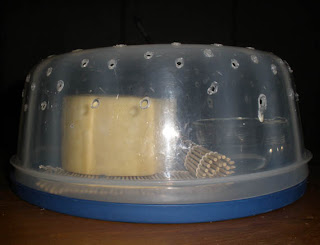A Käser's work is never done.
After standing over my Swiss cheese vat for something like two and a half hours followed by a long night of anxious weight-tending, you might have thought my responsibilities for my latest creation ended with Day One.
Turns out, on Day Two I had to play lifeguard for the better part of the afternoon while my newly-born cheese floated precariously in a salty seawater solution.
Yes, young Swiss (similar to Beaufort, Gruyere, Gouda, and most grana cheeses) need a briny bath before settling down for their long nap. Why? From what I can gather, there are three reasons. First, the saltiness of the brine slows down the bacteria to halt acidification. Second, it makes the cheese nice and zesty (although the cheesy bits I tasted during manufacturing were pleasingly lemony they were a bit bland, I must confess). Third, the salt works to build the cheese's rind. The brine pulls moisture to the surface of the cheese, thus allowing it to form its natural raincoat as protection against unwanted molds, cat hair, strange odors, and other contaminants. Presumably, the rind will also help to keep explosions to a minimum when the bugs inside the cheese start blowing their bubbles.
I made my saturated salt solution with two quarts of water, eighteen ounces of non-iodized pickling salt, a little vinegar and a bit of calcium chloride. I had been reliably informed that calcium chloride is necessary in a new brine, since otherwise its leeching effect would pull calcium from the cheese into the surrounding liquid, causing disintegration, rind-softening, and woe. Eager to stave off disaster, I did as I was told, and added an extra quarter-teaspoon for good measure.
I sprinkled some dry salt on the exposed surface and went for coffee with DMR.
Can you believe there are cafes on this planet that still don't offer soy milk for their lattes? I have said before I live in the back of the beyond, but once again this sad fact was brought home to me with a vengeance.
Disgruntled, black coffee turning to acidic rancour in the pit of my stomach, I returned home in a pessimistic mood, expecting my cheese to have fallen apart in its bath during my absence.
Hurra! (that's German for hooray, according to Google). My cheese was in one piece and looking fine. I flipped it, sprinkled it with more salt, and went for a long walk. Afterwards, I felt much better.
Later that evening, I removed my Kleine from the Schwimmbad and allowed it to drip dry overnight.
The next day (Day Three, if anybody's keeping track - thank goodness it was a holiday weekend), I had a new crisis to consider. Since my cheese was nice and dry with no drops of water adhering anywhere on its pristine baby skin, it was time to move it to a humid 55 deg F location for one week. Eidetic readers will recall that this is the exact temperature at which my camemberts are currently hibernating in their cave, bowls of water beneath providing optimal mugginess.
I was concerned for my newest project, however. What if my camemberts were contagious? My cave is not exactly roomy, and I fretted that if I introduced my Swiss cheese into its confines, it would start to grow a fur coat rather than develop its own characteristic waxy rind. Oh, what to do?
I had noticed during brining that my basement temperature was ideal. I know I said it was an unsuitable place for long-term cheese storage, but I reasoned that not too much harm could befall my Käse in just one week.
With a hot nail, a vise-grip, and a big tupperware container, I hurriedly constructed a chamber that would retain moisture but still allow air to flow:
In went my cheese on its trusty sushi mat with a small glass prep bowl full of water. Hey presto - a mini-quarantine-cave!
The cheese will stay in its private room for a week before moving to a much warmer location (probably a quiet corner of the kitchen) for two weeks while its bulges and swells from bacterial respiration. By then, my camemberts will be ready for a move to the main fridge, and the Swiss can move into the climate-controlled cave without fear of picking up any transmittable conditions.
Lifeguard one minute, infectious-disease-ward nurse the next.
The cheesemaker is indeed a woman who wears many Hüte.




No comments:
Post a Comment